Who is Imam khomeini
The Imam's Background
Rouhullah Khomeini was born on the 24th of September 1902. His father was Agha Mustafa Mujtahid Kamareh'i. Rouhullah was the grandson of Sayyid Ahmad, and the great grandson of Deen Ali Shah.
Deen Ali Shah lived in the Khorassan area but due to the civil conflicts among the three tribes: Afshar, Zand and Qajar, he had to leave Khorassan for India. India at that time was a peaceful country, which attracted many immigrants. The main reason behind Ali Shah's departure to India was the advantages Muslims enjoyed in India during that time. India was famous for being peaceful, and we can see this in Saeeb's following saying, who was a famous Persian poet at that time, "All hearts like to go to India."
Sayyid Ahmad, who was Ali Shah's son, was born in India. After a short time, India underwent political turmoil. The Shia, who were in power at the time, lost their authority and the British forces ceased this opportunity and took over. Sayyid Ahmad left India for Iraq in order to free himself of the British rule.
In Iraq, where Shia Imams are buried and their holy shrines are located, Sayyid Ahmad met Yusuf Khan Kamareh'i, who was a pilgrim there. Yusuf Khan invited Sayyid Ahmad to join him in Khomein, and so Sayyid Ahmad entered Khomein before 1825 when Mozzafar al-Deen Shah was in power.
Sayyid Ahmad married Sakina in Khomein. She was the daughter of Mohammad Hassan Baik, also known as Yusuf Khan's sister. They had four children, three daughters and one son. Their daughters were called Sultan, Agha Banoo, and Sahib .Their son's name was Mustafa. Sayyid Ahmad was known to be strict in religious affairs and to defend the weak. His daughter Sahib Khanom, in the words of Ayatollah Passandideh, "inherited the braveness of her father". She took care of her brothers and sisters after losing their father.
Sayyid Ahmad passed away in 1869 in Khomein. His life was full of struggles and hardships. He was buried in Karbala.
Agha Mustafa Mujtahid Kamareh'i --Imam Khomeini's father…
The last child of Sayyid Ahmad and Sakina was born on Thursday evening in Rajab, in 1862 and in the Razi district of Khomein. Agha Mustafa lost his father when he was less than eight years old. He went to a school called maktabkhaneh, which taught Islamic studies. After finishing his education in this school he went to Isfahan to pursue further education. In Isfahan he attended the lectures of great scholars such as Agha Najafi and Agha Fesharaki. After staying in Isfahan for some time, he left for Najaf in 1888. The following scholars are among the many who lectured him in Najaf: Akhond Khorassani, Mirzaye Shirazi, Shaikh Abdullah Mazandarani and Mirzaye Naeen. Agha Mustafa studied there for eight years and gained a degree in 'discretion in passing judgments'. He used his time in Najaf productively and left for Khomein in 1894.
When he returned to Khomein, he was 33 years old. He was young and energetic. Living in Najaf created a suitable opportunity for Mustafa to become familiar with political affairs and different social problems. Thus he used his political experiences when he returned to his hometown. Like other leading figures, he gathered a group to defend and protect his family and people who were with him. After the year 1896, namely after the assassination of Nasser- e-dean Shah, Iran underwent chaos and insecurity, thus Agha Mustafa's role became more distinguished. Due to his good reputation among the people, they gathered round him and saw his territory as a secure and safe shelter, "It was the place to take sanctuary".[1]
Marriage and the children
Agha Mustafa married Hajar, the daughter of his teacher, Haj Mirza Ahmad. This couple had six children and among them was Rouhullah (aka Imam Khomeini), who was born in 1902. All their children, except for their first daughter, were born in Khomein.
Assassination of Agha Mustafa
Agha Mustafa had a shorter life compared to his contemporaries. His enmity against Braham Khan, one of Khomein's powerful figures had grave consequences. Mustafa opposed the Khan's oppressive character and so conflicts arose and this resulted in the loss of Mustafa's life. Charged with many crimes, the authorities arrested Braham Khan and kept him in prison, where he died. The Khan's brothers, who were unable to protest against the local authority, pretended to be obedient. They devised a plan to kill Mustafa on a cold winter day. Their plans were successful as they finally killed Mustafa on the 13th of February 1903.On that day Agha Mustafa was on his way to Sultan Abad, when the brothers of Braham Khan, who went by the name of Reza Qoli and Ja'far Khan, hid in a bush and shot him. The news of Mustafa's assassination soon reached Iraq. People attacked the killers' residence and burnt it down. In addition a large number of people gathered to grieve the loss of this great man and give their condolences to Mustafa's family.
The daily newspaper 'IRAN', reported this tragic event in detail. Azadol Sultan, who was in charge of this case, did his utmost to catch the men in charge of this murder. Sultan Reza Qoli, who was one of the murderers died before he was arrested. Nevertheless the family of Mustafa did not give up and insisted on getting justice. In the meantime Ja'far Qoli Khan, who also took part in the murder, was arrested. Due to Mustafa's family's insistence Mozzafar Al-Deen Shah ordered the execution of Ja'far Qoli, and so he was executed on the 10th of May 1904 in Tehran.
A writer described this event in detail. He wrote: "While the King was on his way to Europe such an incident took place." 'Adab' another newspaper also mentioned this and wrote that "the people of the capital city of Tehran were glad of the outcome of the case".
Mother's family…
Imam Khomeini's mother was called Hajar and she was the daughter of Mirza Ahmad Mujtahid. Mirza Ahmad went by the title Akhond and was the son of Mullah Hussein Khansari, who was one of the offspring of Mullah Hayder Khansari. Mullah Haydar was a great scholar and lived at the time of Shah Abbas the 1st. He wrote two books entitled; Mazyaaayan and Zandol Tassanif.
Mirza Ahmad was born around the middle of the nineteenth century in Khomein. His father led the congregational prayers and gave lectures in the Mosque in Khomein. One of Mirza Ahmad's pupils was Agha Mustafa, who later became his son-in-law. Mirza Ahmad was famous for his honesty and had a good reputation among the people. Akhond died 7 years before the birth of his grandson, Rouhullah.
Hajar (Imam Khomeini's mother)
Hajar was the eldest daughter of Mirza Ahmad and was born between the years 1868 and 1872 in Khomein. Her father was a famous scholar and the leader of the congregational prayers of the central Mosque in that city.
Agha Mustafa was the student of Mirza Ahmad. He married Hajar in 1882. After two years they left Khomein for Najaf. Mustafa continued his studies in Najaf and returned home after 8 years, where he had six children. The last one was Rouhullah (aka Khomeini). Rouhullah was about four months old when he lost his father. Hajar did not let Agha Mustafa's murderers get away easily and fought for justice to be carried out. Although Hajar was young and could marry again, she preferred to spend her life bringing up her children. Her sister-in- law Sahib Khanoom helped her bring up the children. Two of Agha Mustafa's sons chose to be clergymen, so their mother sent them to Isfahan. Morteza and Noor-e-Deen went to howza (university of Jurisprudence and Islamic studies), but Rouhullah was kept in Khomein. Hajar sent Rouhullah to school too so that he would not miss out. Hajjar was quite popular among the people. She died at the age of fifty and was buried in Qom.
The childhood period
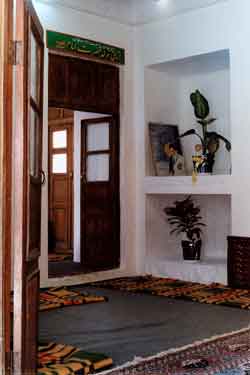 The room where Imam Khomeini was born
The room where Imam Khomeini was bornRouhullah lost his father when he was four months old. His aunt Sahib Khanoom moved to her brother's house to help look after the children. Hajar, Rouhullah's mother, left Khomein for Tehran to make sure justice was carried out for her husband and Sahib Khanoom accompanied her. Rouhullah was left at home with Agha Mustafa's older sister and a nanny, who was called Nanah Khavar and who breastfed Rouhullah.
Agha Morteza, Rouhullah's elder brother, says the following regarding their childhood: "My late aunt Sahib Khanoom took good care of us. Hajar Khanoom also looked after us. Mashadi Qanbar was responsible for our lands. As we did not use the inner part of the house, we lived in the front section of the house. Thus, my mother rented out the inner part to the government."
After learning Qur'an at home Rouhullah went to school at the age of seven. He started to take lessons from Mullah Abul Qasim. He then went to Sheikh Ja'far's Maktabkhaneh. Sheikh Ja'far was his mother's nephew. He was also taught by Mirza Mahmood (aka Eftekharol Ulama) and Seitoti. Eftekharol Ulama and his mother, who was a very learned woman and taught astrology, were Rouhullah's private teachers. They taught him at his house.
As we said before the two elder brothers left Khomein for Isfahan but Rouhullah remained at home. He started his studies in Khomein. He was also taught by Haj Mirza Reza Najafi (aka Agha Najafi), who was his cousin, brother-in law and a Mujtahid. In addition Agha Morteza, Rouhullah's elder brother, was both his teacher and his guardian. Imam Khomeini looked up to Agha Morteza like a son does to a father. He frequently told his son Ahmad "If I had not had a brother like Morteza, I could not have studied". Rouhullah stayed in Khomein until he was seventeen. As there was nothing more for him to learn in Khomein he left.
Khomein's events and Khomeini's experiences
Khomeini's early life coincided with many events in Iran. In Khomein unjust rulers were in charge and the country was unsafe. Life was very difficult for people and with the coming of World War II matters became even worse. Diseases broke out, poverty spread and there were severe droughts. Furthermore the 1929 Coup followed suit.
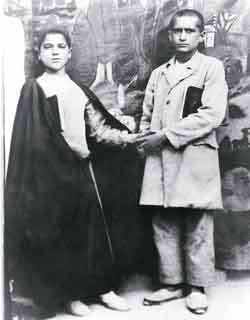 Imam as a teanager (on the right)
Imam as a teanager (on the right)Imam Khomeini witnessed great injustice and oppressive rulers. Rulers would rob their own people. "I myself one day saw the government's men tease and bother a merchant, who was famous for being a good person. I was a small child at the time and was standing in a corner. I saw them hit and then drag the man. They hit him with a hammer. I do not know what happened next. Men such as Einol Dowleh, who burnt people in the market place, were plenty. At that time, the governor of the so-called state paid an amount of money to supposedly help the people then forcefully got back ten times that amount from the people. The people couldn't complain because no one listened to them. There was great corruption, for instance if anyone bribed the governor of Isfahan then he could do whatever he liked and no one could protest. Protesting did not mean anything." [1]
Imam Khomeini both saw and heard about such corruption, as his father's home was a shelter for the oppressed people. Khomeini says "From childhood I was involved in fighting. I have never mentioned this before but we were attacked by the Zallagis and the Rajabalis. We had guns. Even though I was going through the early stages of puberty and I was just a child, I would go to check the trenches because thieves surrounded the area .They sat in the bushes and waited for a suitable time to start their plundering."
Imam Khomeini also recalls some other occasions. He says "When we were in Khomein we built a fort. I had a gun and I was about sixteen years old. Agha Morteza, who was an old man and was good at shooting and taught me how to use a gun. We stood behind the fort and fought against the rabbles who tried to plunder us. It was chaos. The central government was weak and was unable to cope with these thieves. Nayib Hussein, who was a theif controlled the roads of Qom and Kashan. Nayib Hussein and his sons attacked us. Once the Zallagis attacked and captured one of the areas in Khomein and we fought back and tried to defend Khomein."
Imam Khomeini remembers the First World War and the famine, he says the following regarding this matter: "We could find nothing. There was disease, famine, misery and many deaths." The Russian troops entered Khomein and so food supplies vanished. When the war's flames reached Tehran, the politicians decided to change the capital from Tehran to Isfahan. This did not happen due to many reasons. Thus, some of the state men rushed towards the Western part of Iran to form a national government. These groups passed through Khomein on their way to Kermanshah. This created the opportunity for the young Khomeini to observe them up close. Thus, he was acquainted with the current events.
The Imam says I was a pupil when the Russian troops entered Khomein. "It was the 22nd of February 1916 and the First World War had started. An attack was launched against us. The outcome of this blitz was famine, disease and death. There were so many dead bodies piled upon each other that no one could bury them. People had no choice but to bury the dead bodies with the same clothes they had died in, all together. They were buried in the cemetery next to Imam Zadeh Abu Talib."
Cholera spread everywhere and killed many people. It finally reached Khomeini's family as well, and took the lives of their dearest ones. Rouhullah was sick and his aunt took him away to a peaceful place. Luckily he narrowly escaped death. Although Rouhullah's aunt was able to save her nephew she was unable to save herself and she passed away soon after in 1918. Khomeini lost his mother 5 months after this incident.
At this time Imam Khomeini was sixteen years old. He had lost his parents and his beloved aunt as well. From then on he was alone and had to stand on his own feet. When the circumstances improved, he wanted to immigrate to Isfahan and join his brothers there. However he did not go Isfahan as Arak's famous Theology School attracted many students from other areas and so he decided to go there instead.
Immigration to Arak
When Hajj Abdul Karim Ha'eri Yazdi entered Arak he established a School of Theology, which quickly caught up with Isfahan's Theology School and which at the time was the best in the country. Therefore, Rouhullah decided to join this newly established Theology School and so went to Arak, which is 60 kilometers away from Khomein. There, Imam Khomeini studied for one year under the great scholars Sheikh Mohammad Ali Borojerdi and Agha Sheikh Golpayegani. During this time he also studied the book Sharhe Lame' by Agha Abbas Araki.
Immigration to Qom
Imam Khomeini did not stay long in Arak because Haj Sheikh Abdul Karim Ha'erri Yazdi left Arak for good and went to stay in Qom. Four months after the departure of Abdul Karim, Imam Khomeini also went to Qom and settled down there. He had a small room in Darol Shafa School and continued his studies there. He could not attend Abdul Karim's lessons at the beginning. He had to finish his general studies and education first. Therefore he attended the classes run by Saied Ali Yathrebi, Adib Khorrasani and Hajj Mohammed Taqi Khansari.
Imam Khomeini was finally able to attend Sheikh Ha'erri's classes. Under Sheikh Ha'erri's supervision he specialized in particular areas of Islamic studies. His main courses were taught by Shaikh Ha'erri. Imam Khomeini never missed any lessons given by any scholars. He attended the classes that were run by: Hajj Mirza Javad Maliki, who was the author of Assrarol Salavat, Mirza Abol Hassan Rafiee Qazwini, who was the writer of Do'aya Sahar (He was in Qom from the year 1962 to 1968), and Agha Sheikh Reza Mohammad Reza Masjid Shahi, who was the writer of Wagayi'ol Athaan and who lived in Qom from 1965 to 1967.
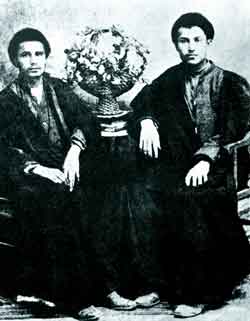 Imam Khomeini (on the left) as a young man
Imam Khomeini (on the left) as a young manImam Khomeini focused on the lessons of two outstanding lecturers: Ayatollah Hajj Abdol Karim Ha'erri and Ayatollah Mirza Mohammad Ali Shah Aabadi. The former was a great scholar, and had a high status among the scholars of theology. He had studied under great men such as Mirza Mohammad Hassan Shirazi, Akhond Khorassani, Kadhim Yazdi. The latter also met great intellectuals such as Mirza Hassan Ashtiyani, Hassan Khallili and Mirza Hashim Rashti
Imam Khomeini was so fond of the lectures taught by Ayatollah Ha'erri that he composed some verses of poetry describing them:
Spring has arrived and become the envy of paradise/ The flowers have blossomed like the appearance of a loved one.
Due to his coming, the world will be full of science and empty from ignorance/ like Qom which became the best city of the country due to the arrival of Sheikh Ajal
Perfect grand, complete bounty, generous ocean, endless treasure/ Abdul Karim the mine of generosity, the shelter for the Muslims
The bearer of the treasure of knowledge of the salaf, the fountain of the descendant's knowledge/ God generously bestowed him with the leading role of religion
In his shadow has gathered the proclamation of religion of every land/ Students of Islam come to him from all lands
Oh God! Make him live long and increase his dignity / As he revives the religion of the best of the messengers.
He has also recited the following verses in this regard:
Establish Qom's theology school for the world/ In order to lead the Muslims to the right path
Oh God! Give a long life to the generous man named Karim / And bestow Your favour on him like pouring rain.
Bless his followers with everlasting goodness/ Befall his enemies with misfortune and melancholy
He has also written the following verses:
His name keeps the name of Islam alive;
I look around and see every heartbroken man thinking/ Arise O king (i.e. God) and help the faithful especially this gift who is the supporter of Islam
In fact if this sign (i.e. Ha'erri) had not been in this land/ If Islam's boat had not had a captain
If his sword had not been to fight against the enemies
There would not have been any sign of Islam left…..*
He met and was with some scholars who were the real leaders of the country. They were indeed the heads of Shi'a faith. Their ways were the same as the Prophet's (saw) ways. Master Hajj Sheikh Abdul Karim Ha'erri was at his time the leading figure of Shia Muslims around the world. He was a very humble man. He was so modest that he had his meals with his servants. He sat on the floor and was very friendly with his students. During the final years of his life, he became ill and so would put a material round his head and walk in the evenings with his slippers on. Nothing could scar or decrease his dignity and greatness.
Other high-ranked scholars were the same and had a very simple life. They stayed away from Satan, which never leaves some. They acted like ordinary people. They would buy their needs from the market themselves. Furthermore they had a separate job in order to earn money to live. They were not at all arrogant and did not walk or talk with an air of pride. Although they were great men they were so modest that it shocked many. They were popular and people really respected them.
Ayatollah Shah Abadi, had the most effect on Imam Khomeini's personality. Imam Khomeini respected him highly throughout his life. He always mentioned and remembered him. Ayatollah Shah Abadi was not one of those men who sat in a corner in solitude. He was not a person who only thought of rescuing himself. He was a political and social scholar as well and tried to defend Islam. It was these characteristics that made Imam Khomeini fond of him. Imam Khomeini insisted on taking part in his lectures and adopted his manner.
The story of Imam Khomeini's acquaintance with Ayatollah Shah Abadi is interesting. The Imam himself told this story to his son Ahmad, and said: "I was introduced to him by one of my relatives. I met him in FeiziyehSchool. I asked him a question about one of the affairs of the mystics and he gave a good answer. Therefore I thought him to be the great scholar I was looking for. I found him well informed and followed him and kept insisting that he accept me as one his students. However he refused, and so I asked if I could take only one lesson. By this time, we had reached the Abedin Cross road. He thought I wanted to take philosophy, so he accepted. I explained that I had finished philosophy and so he repeated the same negative words, 'No'. I carried on insisting. He finally gave up and accepted me as one of his students. I studied Fosoos and Miftahol Gheib next to him for around seven years."
Sayyid Ahmad says: "I asked the Imam how many students were there and he said: 'the maximum was three, but most of the time I was alone. He taught me divine mysticism.'" Sayyid Ahmad adds that "I asked did you study any other lessons under the supervision of Ayatollah Shah Abadi? The Imam answered, 'I studied Meftahol Gheib on Thursdays and Fridays and holidays. I also wrote footnotes to Meftahol Gheib while I was studying Meftahol Gheib and Fosoos.' I asked what else did you study and the Imam answered: 'the book named Manazenol Saereen. Sometimes one or two other pupils joined us, but they wouldn't stay for very long. I told Shah Abadi that the matters you are saying are not in any book, where do you learn them from? He replied "it has been said". Which meant that these are my own words. I owe him so much. He was well informed and was very knowledgeable in both philosophy and. Mysticism.'" Sayyid Ahmad also asked: "How long did you study Mysticism next to Ayatollah Shah Abadi?" The Imam answered: "I cannot really remember I think I studied five or six years. When Ayatollah Shah Abadi came to Qom, I was a bachelor. I continued studying even after I got married."
During these years Imam Khomeini benefited a great deal from Shah Abadi's lectures. His personality had such an effect on Imam Khomeini that any time the Imam spoke of him he added" May I be sacrificed for him". The Imam kept in touch with him even when Agha Shah Abadi moved to Tehran and attended his congregational prayers eagerly. This relationship was so strong Imam Khomeini's father-in- law once said "Rouhullah comes to Tehran to meet Agha Shah Abadi and then he asks for his wife." It was perhaps due to these words that the Imam said, "No one knows Ayatollah Shah Abadi as I know him."
He wrote his first book entitled Sharhe Doaye Sahar, which is about mystical and philosophical questions. He wrote this book in Arabic at the age of 27. He was one of the outstanding figures in the Theology School of Qom. Imam Khomeini gained his degree in analytical thought when he was thirty-five years old. The book Aeeneye Daneshvaran Introduces him as follows:
"Imam Khomeini is one of the studious scholars. He has gained a great deal of knowledge from the philosophical and Mystical lectures, which were taught by the scholar Ayatollah Shah Abadi the majority of the time. He spends most of his time studying and teaching the books of Sadrol Motaal'een, which are philosophical mystical and ethical books. He was one of the experts in these areas while these books were published. His lessons were so interesting that I always remember the verses of poetry he recited:
For my friend's desire, I sacrificed my life I left my home and my family for the sake of my friend"
Imam spent most of his time studying the mystical, philosophical, and ethical books and teaching and writing books. In the first and second decades of his stay in Qom, he was busy writing. His main activities were surveying different sources within his field of study. He started teaching philosophical books from 1928 in the Feizieh School. One of the Imam's students, says the following: "The Imam was chosen as one of the outstanding scholars in the year 1937. At that time, he was only thirty-six years old. He would come to school in the afternoons and sit in front of one of the student's rooms, which was located in the Western corner of the school. There he would have discussions with great scholars such as Sayyid Mohammad Yazdi (aka Damad), Sheikh Hassan Novee ,and Sheikh Fadhil Lankarani……I have heard from some of the students that from the start of the year (1939) Agha Rouhullah Khomeini will start teaching Molla Hadi Sabzevari's book regarding astronomy…..He had his own method of teaching. It was different from the other scholars. He himself was very educated in these fields."
Writings and compilations
From 1928 Imam Khomeini started to write many books .These books can be divided into seven different fields: 1-Philosophy & Mysticism, 2-Theology, 3- Principles of Jurisprudence, 4-Ethics, 5-Commentary on the Quran, 6-Literature and Poetry, 7-Politics and Leadership.
The Imam's political views
There are many available documents showing Imam Khomeini has reacted toward political and social affairs. He defined his political position, quite clearly and vividly. His aforementioned presence in trenches where robbers threatened to plunder his city, proves Khomeini's braveness.
In the year 1927, when the scholars of Isfahan protested against compulsory military service and other injustices they went on strike, Imam Khomeini supported them and Ayatollah Passandideh, who was the Imam's elder brother, joined them in this strike.
Another outstanding instance is the Imam's activities during the year 1929. In this year, the Scholars of Tabriz were exiled to Qom. The Imam met with Agha Mirza Sadiq and Ayatollah Agha Hussein Qomi, who were strong opponents of the regime.
Imam Khomeini has composed some verses regarding this time:
How long do these nobodies want to be our leaders? / How long do these robbers want to guard these nobodies? How long do we have to stand English injustice? They are unique in their cruelty.
In addition, in another poem he addresses Imam Al-Mehdi (as), who is the absent Imam and asks for help:
"O King! These are Islam's affairs, which are disheveled
On such an Eid, when everyone should be singing with happiness
Everywhere I look, I see sad people, O King! Rise and help the faithful"
Marital life
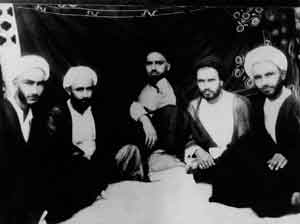 Imam as a young man (second from the right)
Imam as a young man (second from the right)Imam Khomeini got married at the age of 27, this was relatively late at his time and was due to his devotion to his studies. He married the daughter of Mirza Mohammad Thaqafi in 1929. Thaqafi was one of the scholars of Tehran. Imam Khomeini had seven children. Two sons and five daughters, his son's names were Mustafa and Ahmad. His daughter's names were Seddiqa-Khanoom, Farideh, Fahimeh, Sa'eedeh and Latifeh. His last two daughters died during their childhood.
Imam from 1941-1961
The fall of Reza Khan (1939)
The fall of Reza Shah marked the start of Iranian History. The tyrant Reza Shah and his dictatorship collapsed suddenly. Although it was temporary, the people who had endured this dictatorship had a chance to be free. In these new circumstances, the political situation changed and those advocating freedom had an opportunity to present their idea and move towards a free country with free people.
In this rare occasion, the religious activists also started a movement and publicized it. One of the religious figures was Ali Akbar Hakami Zadeh. In 1943 he wrote an essay entitled "The Thousand Year Mystery", which consisted of about 38 pages and was about the Wahabi sect and the Shi'a.
This essay was quickly distributed among the people. People talked about it everywhere, some supported it and some opposed it. At that time the people's faith was weakened, in danger and under threat. Imam Khomeini came as a saviour. He acted decisively in order to fight with religious corruption and save religion. He decided to leave and give up his teaching in order to stand against the threats against religion. He used the best of his knowledge to ruin the foundations of Hakami Zadeh, which were misleading. Imam Khomeini has said the following when recalling those days:
"One day while I was going to Faydhiah School I noticed that some people were talking about the 'Thousand years Mystery' essay! Suddenly it struck my mind that we are teaching ethics while such matters have infiltrated into the Theology Schools and have become the main talk of students."
As a reaction to these circumstances and as a reply to the 'Thousand years Mystery' essay, the Imam went into forty days of solitude at his residence and wrote a book called Kashfe Assrar "Uncovering the Mystery". This book was based on the Qur'anic text, prophetic hadiths, and was supported by Greek philosophical viewpoints.
Another essay written by Imam Khomeini was published on the 5th of May 1944. This essay shows the Imam's opinions:
"Selfishness and neglecting to rise in the name of God have led us to these dark days. It has made us so weak that the entire world has taken control over us.… O clergymen! O Muslim scholars! O religious spiritual leaders! Read what God has told us to do and change your ways. Choose and practice God's reforms. Choose the way God has offered us. Accept God's words and avoid relying on personal benefit. In this way, you will achieve prosperity in the world."
Inviting Ayatollah Borojerdi to Qom
The Imam kept on trying to achieve unity among the Islamic scholars. He finally succeeded in fulfilling this aim by convincing the Islamic scholars to invite Ayatollah Sayyid Hussein Borojerdi to move to Qom. In doing so he was able to make Ayatollah Borojerdi one of the main and central advocators of unity. This and the Imam's efforts and hard work resulted in a united board of clergymen.
Ayatollah Borojerdi left Borojerd for Tehran in January 1945. According to Imam Khomeini, this move had many positive outcomes, and strengthened and united the clergymen.
One of these outcomes was the reform and reorganization of the Howzeye E'lmiah of Qom. This made scholars more aware of political affairs and more effective in their responses to political situations.
Although Imam Khomeini was a remarkable scholar, nevertheless he attended the lectures given by Ayatollah Borojerdi.
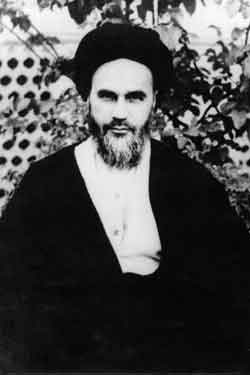
After this achievement, other positive outcomes followed. Two examples of this were setting examinations for clergymen and establishing a board which dealt with the clergymen's different affairs.
The national movement
Along with the gradual improvements in the central Feyzieh School, the country's political atmosphere underwent some changes. For instance the national movement for the nationalization of oil was founded.
Imam Khomeini was up to date with daily events and tried to find the real reason behind the occurrence of such incidents. This was at a time when the atmosphere within the Feyzieh School was one of indifference. Clergymen opted to stay out of political affairs, and refused to challenge the regime. Although the Imam tried to inform Ayatollah Kashani of his political views in a letter, Ayatollah Kashani did not see the need to acknowledge the Imam's opinions. The Imam at that time was one of the most political and educated scholars of his time and was a representative of Ayatollah Borojerdi.
In 1953 Imam Khomeini carried on investigating the conflicts between the theology students and the security forces. The Taraqi newspaper relates that, "Our reporter went to Ayatollah Borojerdi's place. The Ayatollah said, 'You had better talk to my formal representative Agha Haj Sayyid Rouhullah Khomeini'." It has also been said that Imam Khomeini visited the Shah as a representative of Ayatollah Borojerdi on two occasions. This was to inform the Shah of the stance the Feyzieh School was taking.
The start of political confrontations
Religious authority
Imam Khomeini's classes were the most crowded classes in that decade. Most students tried their best to attend his lectures. The Imam's new method of teaching, outstanding approaches, and new ways of making the students understand, attracted many students. The most outstanding feature of the Imam's classes was the discipline that was practiced in his classes.
According to a report by the 'SAVAK' (Shah's Secret Police), Imam Khomeini's classes were unique compared to the classes of other scholars. While the most famous scholars had forty or fifty students in their classes, the Imam had five hundred. This gap was enormous and indicates the popularity of Imam Khomeini's classes.
The same reports also added that among the high ranking spiritual scholars, three were interested in social affairs and Imam Khomeini was one of them. Furthermore due to the fact that Ayatollah Borojerdi was getting quite old, SAVAC decided to make sure they knew even more about the School. SAVAC investigated all aspects of the Feyzieh School and knew about the school's minute details. SAVAC investigated the lives of nine leading scholars. The third scholar on this list was Rouhullah Khomeini, and the following was written about him: "He lives in Qom. He is an anti- communist. He is interested in social affairs."
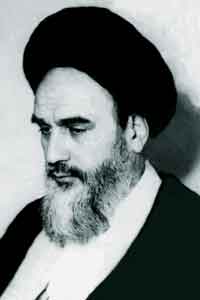
Ayatollah Borojerdi passed away on the 10th of March 1961. The issue of who would become his successor became one of the most important issues for Shia scholars. While the Ayatollah was alive no one disputed his authority and his knowledge but when he passed away there was no unanimous agreement as to who should be his successor.
In light of the circumstances, different religious authorities decided to present themselves to the people by holding gatherings mourning the loss of Ayatollah Borojerdi and honoring him. The only personality who avoided doing so, even though his students insisted he did, was Ayatollah Khomeini. Furthermore the Imam did not attend any of the gatherings.
Imam Khomeini decisively rejected accepting the role as the next major religious authority. The Imam's students advertised and took various measures in order to ensure that the Imam was chosen as the successor of Ayatollah Borojerdi. However the Imam disagreed with this and told his students: "I do not want anyone taking any measures to make me the next great Religious Authority". Nevertheless his students carried on insisting that the Imam should accept this position. Finally, after much persuasion, the Imam accepted this critical and highly sensitive position.
What was quite odd was that the Shah only sent his condolences for the death of Ayatollah Borojerdi to Ayatollah Hakim, who was living in Najaf at the time.
Reason for beginning the campaign
From the beginning of the Pahlavi dynasty, Imam Khomeini was among the opposition and he had his reasons for this. He expressed his dissatisfaction in various ways and as soon as he got an opportunity. The most important reasons behind the Imam's strong opposition of the Pahlavi regime were the weakening of Islamic practices by the regime, the dependence of the regime on foreign powers, and fighting with oppression and tyranny.
With the establishment of the Pahlavi regime great oppression surfaced and a particular enmity against religion was seen. During Reza shah's rule, oppression had its own shape and form and during the Shah's rule it was different.
Although Imam Khomeini was aware of all of the injustices, he kept quiet. The Imam was waiting for a suitable opportunity to express his views and opposition. Finally this opportunity surfaced for the first time in 1961, when Dr Ali Amini, who was the Shah's prime minister, came to Qom. Amini spoke with four distinguished scholars and among them was Imam Khomeini. Imam Khomeini spoke to the Prime Minister regarding four matters. First he told him what a great responsibility a Prime Minister has and that he should be aware of this. Secondly he told him to take lessons from the fate of previous Prime Ministers. Thirdly he briefly described what the Howzeyeh E'lmiyah did and the benefits it had for the country and lastly he gave some suggestions.
In 1962 Asad Allah A'lami's government changed some rules regarding the regional elections. The condition of being Muslim for both the candidates and voters was removed and the need to swear by the Holy Qur'an when a candidate is chosen to run office was also removed.
This showed that the campaign against Islam was growing stronger. Thus, Imam Khomeini, who was the first protestor to step forward, gave a proposal signed by four highly ranked religious leaders: Golpayegani, Shari'at Madarei, Shahab Al-Deen Najafi Mar'ashi and Morteza Ha'erri. They decided to carry out the following :
1- To send a telegram to the Shah
2- To send letters to religious leaders in cities inviting them to join their protests and movements.
3- Arranging weekly meetings in order to reach united decisions regarding what course of action needs to be taken next.
The Shah gave a short and belittling reply so it was decided that a telegram should be sent to Prime Minister A'lami. The campaign that the Imam had started spread quickly and many people joined and supported the movement. Many telegraphs were sent back and forth between the government and the scholars. In addition there were major demonstrations in Qom, Tehran and other cities.
The people's reaction forced the regime to retrace its steps and after around two months it was announced that the aforementioned changes made in the laws of regional elections were not possible and so the laws had to be changed back to their previous system.
The Shah's white revolution & the second conflict
After the setbacks the government faced in the regional Assembly, the government tried to implement a plan called "the white Revolution". This was introduced by the U.S President, Kennedy. This plan supposedly protected pro-American countries such as Iran from falling into the Soviet Union's snare by introducing a series of economic and land reforms.
This plan had six items, which were to be carried out. It was presented in a way which didn't look bad to many people. However, the Imam's sharp eyes soon found out the real reason behind such measures. He could see that behind this colorful curtain there was nothing except U.S domination. Thus, the Imam removed the curtain in order to make people aware of the reality of the matter. He warned people not to fall into such a trap which was laid by the enemies. Imam Khomeini tried his best to awaken the other religious leaders. He made people aware of the depth of the betrayal hidden in these proposals.
Many representatives were sent back and forth between the Shah and the religious scholars. However an agreement was not reached and neither backed down on their views. This resulted in Khomeini issuing a juridical decree which forbade anyone form taking part in the vote to accept or reject the six proposals or principals.
On January the 23rd 1963 the regime's armed forces launched an attack on the people of Qom. The next day the Shah entered Qom. Although the mayor of Qom and other government officials tried hard to make the scholars show up in the Shah's welcoming ceremony, they were not successful. According to the Imam the reasons for this were the following:
"Yesterday a savage attack by government officials was launched on the honorable people and scholars of Qom. The respectable status of scholars was insulted. Furthermore the inhumane crimes committed against the people of Qom and the community of religious scholars and the attack on the holy sanctuary of the Howzeh has left no room for any dialogue with the government. In addition there no longer exists any possibility of holding talks with the Shah."
The Imam then stated that only if two conditions were met would talks be held with the Shah. The first condition was removing A'lam from office and the second was ceasing the attacks on the people by the police. It was difficult for the regime to accept both conditions.
The Shah entered Qom on the 25th of January while the police had taken control of the entire city. The majority of the people who were listening to the Shah's speech did not belong to the city of Qom. No scholars or lay people, who lived in the city of Qom, attended the Shah's speech. The Shah became very angry, shouted abuse, and insulted highly ranked scholars. He then left Qom very quickly. This occurrence caused a deep rift between the regime and the religious leaders. As a result the country saw a series of bloody events.
The coming New Year was a different one. Imam Khomeini announced that there should be no celebration this year and that the people should mourn the loss of their brother's and sister's lives. In addition the Imam stated that the "Regime is trying to implement laws, which will endanger the religion and Islam".
Towards the end of 1963 the Imam made another announcement and said: "The unjust regime should be aware that if it wants to act against Islam and its decrees, and if it wants blasphemy to spread in the Muslim cities, I am ready to stand against it. I will protect Islam and the Muslims until the last moment of my life. So long as I am alive I will not allow anti-Islamic laws to be introduced and practiced. I will not allow the oppressive regime to throw away the freedom of these people."
Thus when the New Year arrived no celebrations or ceremonies were held. Suspicious figures under cover, who claimed to be farmers, hanged around. This indicated that there was grave danger lying ahead.
The attack on Faydhiah School
On the 22nd of March 1963, which was the anniversary of the martyrdom of Imam Ja'far Al-Sadiq (as), undercover government officials were looking for any excuse to attack the gatherings of scholars and religious authorities. They tried to frighten the people and create a panic stricken atmosphere. They entered the Imam's residence but they were made aware of the Imam's threats by the Imam's representative. It was this that stopped the armed forces from attacking the people at Imam Khomeini's residence.
In the afternoon of the 22nd of March 1963, the armed forces launched a brutal attack on the Faydhiah School. This attack against unarmed theology students was unique in Iranian history. This act of violence was followed with some very important historical events: Imam Khomeini's speech on Ashura; Imam Khomeini's arrest, and the events that took place on the 5th of June. In addition on January the 7th 1978 an insulting piece was written regarding Imam Khomeini and published in the Ettela'aat Newspaper. These two mistakes had dire consequences and led to the fall of the Pahlavi regime.
The unarmed students, who lived in the Faydhiah School dormitories, were unaware of the attack awaiting them. They were unarmed while the police forces were well equipped with weapons of all sorts. They shot at the students and there was blood all over the walls and panic took over. The school changed into a battlefield and in less than an hour all rooms in the school were filled with blood, turbans, dead bodies, and torn books. It is impossible to describe this devastating scene.
At this time the Imam gave a statement to the people, which showed his braveness and steadfastness:
"Do not worry; keep fear and weakness away from yourself. You are the followers of a leader who stood against hardships. He was patient. He was decisive… Our great leaders endured events like the day of Ashura and the eve of the 11th of Muharram. So what do you say today? Why are you worried? The brutal regime has showed its true colours and brutality by committing such a crime. It has showed its Changeez-like characteristic very well. By carrying out this catastrophic and bitter incident the regime has made its fall a definite matter. We have won."
According to Ayatollah Khamenei, the Imams words "gave us piece of mind and it made us calm. We felt like we were not afraid of anything at all". Imam Khomeini also said the following while addressing the Pahlavi regime: "I have now made my heart ready for the spearheads of your armed forces but I will not stand your bullying and will not bow down to your oppression."
The opportunity that the Imam had been waiting for presented itself after two months. Muharram was an eventful month. The Imam sent special messages all over the country and told people what was needed for his campaign. He made sure people knew what had happened. In one of his speeches, while addressing the students. He said that he had told the Shah to stop taking such extreme measures against the people but the Shah paid no attention and so the Imam said: "I will not sit still until I make their days dark and their lives a misery."
Qom experienced eventful nights in Muharram. The Imam was invited to different ceremonies each night and the mourning for Imam Hussein was mixed with a political atmosphere. These ceremonies and political gatherings reached their peak on the day of Ashura, when Imam Khomeini gave a speech. The Faydhiah School was filled with people and crowds even stood outside the school to listen to Imam Khomeini's words. A man who had come from Tehran to Qom in the morning to inform the Imam of grave danger was faced with the following reply of the Imam: "We will teach them a lesson today."
While the crowds gathered a preacher spoke to them until Imam Khomeini arrived. When the Imam arrived he started his speech by recalling the oppression Yazid and Mo'awiya inflicted on the Prophet's family and he linked this to events of the 22nd of March. He called those who acted on that day the agents of Israel. He then addressed the Shah and said:
 Imam giving a lecture to a group of clergy man in the Faydhiah School; Qom
Imam giving a lecture to a group of clergy man in the Faydhiah School; Qom"Agha I will give you a piece of advice. Do not carry out such actions. Listen to me. Listen to the spiritual leaders. Agha Shah! O Mr. Shah! I will give you a piece of advice. Stop committing such acts. Agha they are fooling you. I would not like to see people thank God the day you leave this country."
Imam Khomeini addressed the Shah with unique bravery and then gave him the following piece of advice: "Think for a while. Think everything over. Consider the outcome of the affairs. Take lessons from your father's fate. Agha, stop carrying out such acts! Listen to the spiritual leaders. Listen to the religious scholars. They want what is best for the nation. Agha! Why are you trying to fool people so much? Why are you spreading so many lies? Stop it O misfortunate one. Don't you know that if one day a problem arises not one of these friends you have will help or assist you? They are all friends of your Dollars. They have no faith or religion. They are unfaithful." "We feel pity. We pity the current circumstances in Iran. We feel sorry for this ruined country. We pity the government".
On that day, Imam Khomeini spoke directly to the Shah for the first time. The Imam challenged the Shah's greatness and power. So far the attacks had been directed to the government but now it was directed to the Shah.
Imam Khomeini's sharp and piercing sentences against the Shah made everyone tremble. All the people were shocked, and even Agha Mustafa the elder son of Imam Khomeini started to panic and wanted the Imam to finish his speech as soon as possible.
The Imam's words had such an effect on the regime that they were shocked and there was no reaction for thirty hours. The regime's officials were also dazed and unable to come up with a suitable course of action. On the other hand, Imam Khomeini's words were spread very quickly and the whole country knew what the Imam had said. As a result the regime was dealt a great blow. The Imam's brave move not only made people happy but encouraged his followers to stand up for their rights and beliefs such that the people were prepared to face any dangers in pursuit of their aim.
The 11th of Muharram passed calmly, however on the 12th night Imam Khomeini took part in a gathering in the Hakeem district. When he returned home his supporters made a circle around him in order to protect him. That night people in Qom went to bed as usual. They were unaware of the event, which occurred at midnight in the Yakhchal Gaazi District. The following morning Qom and some other cities witnessed bloody events.
The arrest of Imam Khomeini
The series of measures carried out by Imam Khomeini increased daily. The regime noticed this was something quite distinguished and that the continuation of the protests would endanger the foundations of the regime. Trying to fight a great religious leader was not easy and public opinion prevented the regime from making a quick move. However the regime decided to take a great risk and arrested Imam Khomeini.
At 3:30am on the 5th of June, SAVAK agents led by Qom's police forces attacked Imam Khomeini's residence. They arrested him and sent him to Tehran Immediately. When the armed forces attacked Imam Khomeini's house, the Imam came forward and said, "I am Rouhullah Khomeini, leave the others alone. Do not bother them." Imam Khomeini said the following with regards to these events: "When they broke the door of the house I realized they have come to arrest me…. I thought they might make a mistake and take Mustafa instead, and so I said that I was Khomeini. I was ready to be arrested. They arrested me. As the street was narrow, they put me in a small car first. Then when we reached the end of the street a big car was waiting and they put me into the car and we drove away. One person sat on my right side and another on my left. One of these men cried from the beginning to the end and put his head on my hand and was leaning on my arm, while the other kept kissing my shoulders."
When they reached Tehran, the Imam was sent to Biseem barracks. Later on the same day he was sent to Qasr prison. News of the Imam's arrest reached the Yakhchaal Qazi District and in no time at all spread all over Qom and Tehran. In Qom people rushed out in the streets with tearful eyes and went towards the shrine of Hazrat Ma'soomeh. Religious leaders joined the crowds and preachers vocalized their disagreement with the Imam's arrest.
The cries of men and women shook the city and crowds started to move towards the southern door of the shrine and towards the Ahanchi Bridge. From there they went to the train station. At the train station armed forces appeared and started shooting the people. There were four jets flying very low and the sound was deafening. Within a few minutes Qom turned into a war zone. On that day, women stood with their men and protested for the freedom of Imam Khomeini and took a stand for their beliefs. By noon officers were able to disperse crowds and empty the streets. In doing so they killed many men and women, and the streets were filled with blood.
The events in Tehran were much more vast and extensive. As soon as the news of the Imam's arrest reached Tehran, crowds from the Southern and Eastern parts of Tehran filled the streets. The angry crowd shouted: "Death or Khomeini". Near the big central Bazaar and The Shah's Mosque (today known as Imam Khomeini's mosque) armed military forces come to 'control' the crowd. Serious conflicts arose between the armed military forces and the unarmed demonstrators. Police brought tanks and artillery guns to be able to cope with the crowds. Streets such as Molavi, Siroos were like scenes of a battlefield. The conflicts carried on throughout the afternoon up until the evening. When the students from Tehran University wanted to join the demonstrators the military forces aimed their guns at them and they dispersed.
The severity of the conflicts increased to such a degree that the Shah phoned commander Ovaisi every ten minutes to get the latest news on the situation. Gradually night fell and people scattered. According to commander Fardoust, "The demonstration on the 5th of June 1963 was quite unorganized. If the demonstration had been organized beforehand and two matters were observed there is no doubt that it would have resulted in the fall of the Shah. Until midday the Shah, the English and the Americans had thought that, the demonstration was prearranged and its aim was to overthrow the regime and this put them in a state of panic." On that day the American advisors of the SAVAK gathered in Fardoust's office and gave continuous reports to the American embassy. They only left the office when they were assured that they had been successful in stamping out the protests. The protests in Varamin, Shiraz, Mashad, Kashan and Khameen also caused some disturbances.
Imam's temporary freedom
After being detained for nineteen days in Qasr prison, the Imam was moved to the Eshrat Abad barracks. They kept him as a prisoner there for two months. During this time different courses of action were taken in order to free the Imam. Various religious leaders from all parts of the country gathered and tried to come up with a plan to force the government to release Imam Khomeini. The bazaars in the city of Qom and Tehran also went on strike in protest to the arrest of Imam Khomeini.
Finally after two months of imprisonment, on August the 2nd 1963 the Imam was released and put under house arrest. After enduring eight months of house arrest the Imam was at last given permission to return to Qom. On the 4th of April 1964 Imam Khomeini entered Qom.
Return to Qom
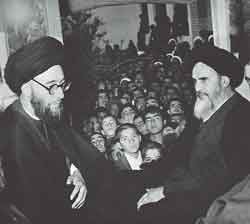 Imam and the Martyr Ayatollah Ghazi Tabatabaee among the cheering crowd(Qom,1964 -after the Imam's released from prison)
Imam and the Martyr Ayatollah Ghazi Tabatabaee among the cheering crowd(Qom,1964 -after the Imam's released from prison)On the 4th of April 1964 general Mobasser, who was the chief of all the mayors of Iran's cities, sent a telegraph to Qom informing the mayor of the following: "Imam Khomeini is being sent to Qom along with commander Molavi. He will be living in his own residence. …This is a top-secret matter and nobody should know about it." Despite the fact that such precaution was taken and the Imam entered Qom late in the night, Imam Khomeini's house was packed with people. Until dawn, Howzeh students visited the Imam in turns. According to the police reports only a short while after the Imam's arrival five thousand people rushed to visit him.
People felt happy and congratulated each other. They put pictures of Imam Khomeini and lights up. The cities of Qom, Tehran and Kashan also held celebrations. On Friday the 1st of April the Imam reemphasized his position via a speech and showed the people that imprisonment and threats could not waver his decisions.
The Etela'aat Newspaper claimed that the clergymen and religious authorities had reached an agreement with the Shah and had accepted the white revolution. Imam Khomeini replied to this accusation and said: "If you hang Khomeini he won't reach an agreement with the Shah. You cannot bring about reform using spears…. I am not the type of clergyman who sits in a corner and holds rosary beads in his hand. I am not like the pope, who on Sundays leads mass in church and the rest of time acts like a king for himself and does not pay attention to other matters…… I must rescue this country save them from these hardships."
A few days later Imam Khomeini also said: "What we say is that these gentlemen should abide by the constitutional laws…. If you are religious, act according to the religion and If you do not accept religion, abide by the constitutional laws. I am not one of those men who issue a ruling then forget about it. I make sure a ruling I have issued is carried out……and thanks be to God I am not afraid of anything at all. By God I have not been afraid up till now. The day they arrested me, they were afraid and I kept telling them not to be frightened."
 The people welcoming the Imam after being released from prison(Qom)
The people welcoming the Imam after being released from prison(Qom)After the people had finished coming to see the Imam and he had replied to all congratulatory letters and messages, he resumed teaching. He used every opportunity to make people aware of the current affairs and political situation of the country.
On one occasion he made people remember the anniversary of the incidents that took place on the 5th of June by releasing a joint statement from a number of religious authorities commemorating the incident and its martyrs. In addition on the 29th of June 1964 Imam Khomeini said to a group of clergymen who had come to visit him: "These times are not for sitting at home and praying, these times are for fighting."
The approval of the Capitulation Bill
From the time he was freed and entered Qom up until November of the same year the Imam expressed his viewpoints at every opportunity. One of the most famous instances was when a bill was approved on the 13th of October 1964. According to this bill all Americans were awarded legal immunity in Iran. Thus if an American committed a crime in Iran, the Iranian courts could not put him on trial. This bill was in fact the same capitulation law which had been previously abolished in most parts of the world including Iran.
On the 26th of October the Imam issued a statement condemning this law. On the birthday of Lady Fatima (as) a group of people visited Imam Khomeini's house. There the Imam gave a very important speech. He started his speech by saying "Surely we belong to God, and to Him we will return". He then continued and said: "I cannot express the sorrow I feel in my heart. My heart is breaking. Since the day I heard of the latest developments in Iran, I have barely slept….. With a sorrowful heart, I count the days until my death comes (the audience weeps). Iran no longer has an Eid; they have turned our Eid into mourning…....They have sold us, they have sold our independence…….Our honour has been trampled on; the greatness of Iran has been destroyed."
What is the Capitulation Bill?
A law has to be taken to parliament, which has been copied from the Vienna Convention. We have to add a provision on the interests of all American military advisers and their families. This covers the technical and administrative officials, and servants- . In short, anyone in any way connected to them are to enjoy legal immunity with respect to any crime that they commit in Iran! If some American's servant or some American's cook, assassinates our high ranked religious authority in the middle of the bazaar, or runs over him, the Iranian police do not have the right to arrest him! Iranian courts do not have the right to judge him! The dossier is to be sent to America so officials there can make a decision regarding it.
The previous government approved this measure without telling anyone and now the present government just recently introduced a bill in the senate and settled the whole matter in a single session without breathing a word to anyone.
A few days ago, the bill was taken to the lower house of Parliament and there were discussions, although a few deputies voiced their opposition the bill was passed. They passed it without any shame, and the government shamelessly defended this scandalous measure. They have reduced the Iranian people to a level lower than that of an American dog. If someone runs over a dog belonging to an American, he must be prosecuted.
Even if the Shah himself were to run over a dog belonging to an American, the Meridians could prosecute him. However, if an American cook runs over the Shah, a religious authority of Iran, or the highest official, no one will have the right to object. This bill was passed because the regime wanted a loan from America and America demanded this in return! This is apparently the case. A few days after approving such a measure, they requested a $200 million loan from America. America agreed to the request. It was stipulated that the sum of $200 million would be paid to the Iranian government over a period of five years. Furthermore, $300 million is to be paid back to America over a period of ten years. Do you realize what this means? In return for this loan, America is to receive $100 million in interest! In addition to this, Iran has sold itself to obtain these dollars! The government has sold our independence, reduced us to the level of a colony, and made the Muslim nation of Iran appear worthless in the eyes of the world! They have done all this just for the sake of a $200 million dollar loan for which they have to pay back $300 million dollars! What are we to do in the face of this disaster? What are our clergymen to do? Where shall they turn to for help? To which country should they present their appeal?
Other countries imagine that it is the Iranian nation which has demeaned itself in this way. They do not know the Iranian government. The government plays the main role. It is the fault of the so-called Iranian Parliament, which have nothing to do with the Iranian people. This is a parliament elected undemocratically, what relation does such a Parliament have with the people? The Iranian nation did not elect these deputies. Many of the high-ranking 'scholars' and religious authorities ordered a boycott of the elections, and the people obeyed them and did not vote. As a result deputies chosen by the regime were seated in Parliament.
The conspiracy to restrain the influence of clergymen
According to a history textbook printed this year and now taught to our schoolchildren, one containing all kinds of lies and inaccurate statement: "It has now become clear that it is to the benefit of the nation that the influence of the religious leaders is rooted out". They have come to understand well that: If the religious leaders have influence, they will not permit this nation to be slaves of Britain one day, and America the next. If the religious leaders have influence, they will not permit Israel to take over the Iranian economy; they will prohibit Israeli goods in Iran! If the religious leaders have influence, they will not permit the government to randomly impose such a heavy loan on the Iranian nation.[1]
Exile to Turkey
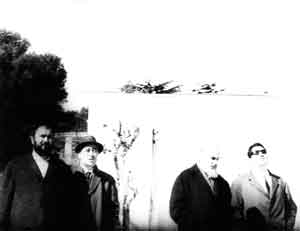 Imam and Sayyid Mustafa Khomeini in exile in Turkey
Imam and Sayyid Mustafa Khomeini in exile in TurkeyAt 5:30 in the morning, they arrested Imam Khomeini. He was deported without delay from Tehran to Turkey. Then a very short report read by SAVAK radio announced, "Rouhullah Khomeini is in exile." They announced it without mentioning the destination. People were very upset about this news but due to the dangerous circumstances at the time they were unable to protest.
They took the Imam to Ankara airport then to Bolvar Palace hotel and the following morning they took him somewhere in Atatoork Street. After a week, the final destination was defined and it was Bursa, which is 460 Kilometers from Ankara. This city was quiet and unknown to the Iranians thus it posed no threat for the Pahlavi regime. This city had no mean of communication and so the Imam had to prepare himself for an isolated life.
The Imam used his time in Bursa well and studied and wrote a book entitled Tahrirol Vasilah. While in Bursa the Imam contacted his friends via letters and he never showed that he was unhappy with the circumstances and never complained. He was content with whatever God had chosen for him and this was expressed in a letter he sent his wife on the 24th of March.
Exile to Iraq
The exile in Turkey lasted 11 months. The regime was forced to change the destination of his exile so the Imam was taken to Iraq. The Imam accompanied by his son Mustafa entered Iraq on the 5thof October 1965. For one week they visited the different cities of Iraq. They then went to Najaf and the Imam stayed there for thirteen years. The Imam thought that Iraq was much better than Turkey.
The period in Najaf was the most defining moment of Imam Khomeini's life. He focused on two matters:
1-Scientific activities
2-Political measures
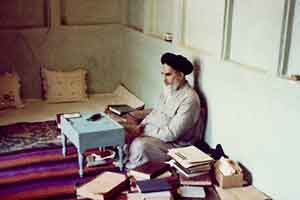 Imam at his residence in Najaf
Imam at his residence in NajafIn relation to scientific activities the Imam paid attention to two main goals. The first was establishing classes and training clergymen. The Second was that he started writing books, which were useful for students. Thus he started to give 'Kharij' lectures in the Sheikh Ansari Mosque. Many students from different countries attended his lectures. He started teaching 'Islamic government' on February 1970 and it came to be his main area of teaching. Later a book was published, which stated the words of the Imam in these lessons, and was entitled the 'Islamic Government'.
In relation to Political measures, Imam Khomeini was restricted and rarely had contact with outside Iraq. However he was gradually able to form connections with anti-regime activists, who were scattered all over the world.
In the book, 'Islamic government', the following has been written:
"You have a duty to establish an Islamic Government. Know that you are able to do this and believe in yourself. The colonialists started their campaign 300-400 years ago and now they have reached this point. We will also start from zero."
The Imam has also said the following during his stay in Najaf:
"Great men, who have an open mind, never give up hope. They never think of themselves. They do not think of their freedom while they are in prison. They try to achieve their goals under any circumstances. If they are unable to attain their goals they leave their work for others to take over. Achieving these goals may take 300 to 400 years. Great revolutions are made in this way."
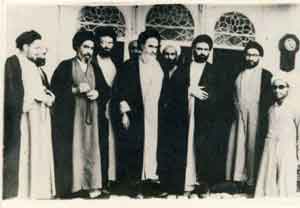 Imam among scholars at the Howza E'lmiyyah School of Najaf
Imam among scholars at the Howza E'lmiyyah School of NajafAnother matter which concerned the Imam in Najaf was the internal disagreements between the clergymen. The Imam tried to solve this problem and in a lecture in the Sheikh Ansari mosque he listed two reasons for such disagreements. The first was the enemies of Islam who played a secretive role in these differences and the second was the personal desires of inactive clergymen.
He never stopped advising the clergymen regarding the characteristics they should possess. He wrote hundreds of letters and gave many lectures. His students recorded these lectures by writing them down and then distributing them among people. The period in Najaf was a defining moment for the Imam as he was able to teach freely and his messages reached the people of Iran via letters. In order to give hope to those who supported him the Imam said:
"Whatever happens do not give up. God is with you. Do not allow yourself to be weak. God willing these circumstances are temporary and they will soon pass".
"Do not despair of God's favours, victory is near."
"I assure you the regime will fall. Those who came before them were defeated by Islam, they too will be defeated…Be patient and stay strong…they are goners and you are here to stay."
"I confidently promise you respectable men that victory is near…..The fire which has lit up inside your hearts and chests will never extinguish… It is possible that you will witness its (the fires) great explosion."
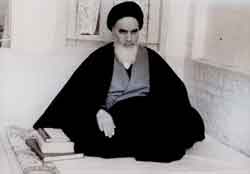 Imam at his residence in Najaf
Imam at his residence in NajafAlthough the Imam was in exile he was still dangerous in the eyes of the regime and put them in a state of constant panic. He retold the events which took place from the year 1963 to1965 in such a way that the listener felt as if he was there at the time. For instance in a letter to Mr Hoveyda, who was the Prime Minister at the time, the Imam wrote: "Mr. Hoveyda it is necessary that I give you some advice…Your unlawful military government…… is a government which belongs to the middle ages, is a government of spears, torture and imprisonment, is a government of suffocation and restriction of freedom, is a government of tyranny and bullies……..Be afraid of God's anger, be afraid of the nation's anger…….Lo! Thy Lord is ever watchful."
On another occasion, he invited people to protest against the ceremony celebrating the 2500 year legacy of Iranian kings, and stated: "The people of Iran have a duty to protest against this ceremony. For God's sake! Write to the Iranian government and tell this man to cancel this ceremony, people are hungry. Satiate their hunger."
In addition, he addressed the scholars and warned them to break their silence and said: "Silence now is the same as choosing and welcoming the death and fall of a great nation. It is necessary to break this silence before this opportunity passes by."
Ayatollah Mustafa's passing
The eldest son of Imam Khomeini passed away on the 23rd of October 1977. It is unknown why he died. He was a very knowledgeable man and could have benefited the Muslim world a great deal if he had stayed alive. The Imam first announced the death of his son in a short statement. Then on the 1st of November he explained how he felt about this tragedy and described the death of his son as the following:
"These kinds of affairs are of no real importance; these things happen. Everyone experiences this kind of thing at some time. God, the Blessed and Exalted, shows His mercy in ways both manifest and hidden. He has a hidden beneficence of which we have no knowledge; a beneficence about which we are uninformed…. That is why we grieve and make a fuss when these kinds of matters arise. We show no tolerance at such times."
Although the Imam had lost his son and despite the fact that he was away from home, he still kept up to date with current affairs and was as active as ever. He was always looking for suitable opportunities to express his views. While addressing Iranians living in Iraq and clergymen, the Imam stated: "Today we have been given a chance. This is an opportunity. Value it gentlemen. Write and object….don't let this opportunity pass." The Imam practiced what he preached and he was the first to carry out his own advice.
When replying to the letters of condolences sent by various religious authorities and clergy men, the Imam not only thanked them but reminded them of their religious and political duties and the oppression of the Iranian regime.
In the following statement the Imam refers to the ceremonies being held to honour and mourn the loss of his son and says: "We are faced with great hardships and heartbreaking tragedies thus we should not mention personal tragedies. The great protests (mourning ceremonies) during this period is a strong reply to the years of useless words said by this unworthy figure (Shah), who destroyed all the respect, honour, freedom and economy of this great honorable nation. He did all this to satisfy his and his plundering family's personal desires and wants."
The Iranian government tried its best to make the Imam look bad and tarnish his reputation so that the people would stop supporting him. Thus on the 7 th of January 1978, the Etela'aat (a newspaper) published an article with the title "Iran and the black and white colonization". This article referred to the demonstrations that took place on the 5th of June 1963 as an 'inauspicious disturbance' and talked of its leader as "A quarrelsome, faithless man who is dependent and devoted to the colonizers".
The people and clergymen of Qom were the first to object to this article and they were silenced with bullets. Once more the shedding of blood caused a deep rift between the government and the people. The regime had tried to ruin Khomeini but saw that the people were ready to lay their lives in order to protect his name and honour. Thus it was as if the 5th of June took place once again. This time the bullets they shot at demonstrators backfired.
Imam Khomeini blamed the Shah for the massacre of the demonstrators. He released a statement giving his condolences for the tragedy that befell Qom. In one of his speeches he assured the people that: "God willing this root (regime) will soon be cut off."
On the 22nd of January 1978 Imam Khomeini sent another message for the people. In this message he said: "Salaams and greetings to the wise and educated Iranian nation, who defend Islam through great oppression and massacres... I give the honourable Iranian nation the good news that the oppressive regime of the Shah is taking its last breaths…."
On the 18th of February, forty days after the massacre of the people of Qom, many cities held gatherings in order to commemorate the martyrs of this incident. During the gathering held in Tabriz military forces attacked the people and shot at them. Thus forty days after the shooting of the people of Tabriz different cities in Iran held gathering to commemorate these martyrs. Due to the fact that the regime kept attacking the people at these gatherings, commemoratory ceremonies kept being held until they attracted media attention.
On the 24th of April 1978 a reporter from the famous Le' Monde newspaper came to Iran to get the latest news on the political changes and shifts in the greatest country in the Middle East. This reporter wrote the following: "Within one of the small alleys of Najaf, where the houses were built into each other in order to act like a shelter against the burning heat of the sun, one finds the humble residence of Ayatollah Khomeini. This house resembles the houses of the poorest people of Najaf. In this humble residence there are no signs of the power of opposition leaders who live in exile. If Ayatollah Khomeini has the power to ignite a rise in Iran then this power is certainly due to his dominance and authority over the views of the Iranian people. Instead of decreasing, this authority has increased tenfold since he has been exiled…" The Imam expressed his views regarding matters to do with the rise of the people, foreign powers and other political groups during his interview with this French reporter.
Exile to Paris
On the 4th of October 1978, the Iraqi government forced Imam Khomeini to leave Iraq for Kuwait. However the Kuwaiti government did not give refuge to Imam Khomeini due to the Iranian regime's request. Consequently, Imam Khomeini flew to Paris.
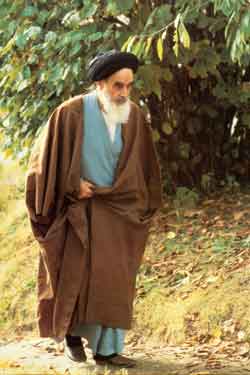 Imam walking in the garden (Neauphle-le-Chateau)
Imam walking in the garden (Neauphle-le-Chateau)The Imam himself explains this event: "They (the Iraqi government) said that: 'due to the fact that we have certain agreements with the Iranian government and the actions of you and your companions do not observe these agreements, we can no longer have you here.' I answered that you have made agreements, I haven't. I have a religious duty, which I will carry out, and I will pay no attention to your agreements. I will preach on the Manbar [1] issue statements and make recordings on tapes and send them. This is my duty. Whatever duty you have, carry it out… I then got ready to leave… under strict Iraqi supervision I went to the Kuwaiti border and the same pressure that was put on the Iraqi government was also put on the Kuwaiti government (and so refuge was not given to the Imam)…from there we returned to Basra and then we went to Baghdad. I realized that whichever Muslim country we go to it will be the same. It was for this reason that, without any previous thought on the matter, I decided to go to France."
During this time, the Shah found himself in a crucial situation where the foundations of the regime were very shaky. He tried to carry out various different measures but they were not successful and angered the people even more. For instance he made it the responsibility of different prime ministers to supposedly change the government. News of the people's anger and of an upcoming revolution spread throughout the world and grabbed Media attention.
On 12th of October 1978 Imam Khomeini said the following to a BBC reporter: "This regime must be overthrown and then…When the parliament is sworn in people's opinion should play the main role." On other occasions, Imam Khomeini explained what he intended to do after the downfall of the Shah's regime.
 Imam exiting the garden (Neauphle-le-Chateau)
Imam exiting the garden (Neauphle-le-Chateau)Replying to one of the Iranian politicians, who claimed that the Imam had endured great difficulties and this revolution or rise was more personal rather than for the people, the Imam said: "I have not been tortured….. So my opposition to this man (Shah) is not due to me being tortured…My suffering is the suffering of this nation. When I remember the faces of people who have lost their children and sons, I am tortured… What tortures me is the tragedy that has consumed this nation. "
The Revolutionary Council
One of the most important decisions made by Imam Khomeini in Paris was deciding to form a revolutionary council. The events in the autumn of 1978 made Imam Khomeini think of changing the regime. Thus on the 11th of November 1978, he assigned the job, of finding suitable and good people to make up the revolutionary council, to Ayatollah Beheshti and Ayatollah Mottahari.
According to the Imam's words, he worked more than sixteen hours a day. He did interviews, gave speeches, read reports, analysed letters and telegraphs and replied to them. The first apparent outcome of the Imam's resistance and permanence was made clear to the world on January the 3rd 1979. On that day the Shah left Iran for an unknown destination. This shocked the world and the Iranian nation were one step closer to victory.
At 20:30 on the same day, the Imam issued a short statement informing the people of three important points:
1- The Shah's exit from Iran is the first step in ending the domination of criminals. It means the end of many years of rule by the Pahlavi regime ... This is due to the heroic campaigns of the Iranian nation. I congratulate this first phase of victory and I will issue a statement regarding it.
2- Soon we will introduce a temporary transitional government in order to carry out parliamentary elections and approve the constitutional laws.
3- I will return to Iran at the first suitable opportunity."
Return to Tehran
The Historical Return
After the Shah's departure, people were eager for Imam Khomeini's return to Iran. In Tehran ceremonies were being organized to celebrate the Imam's historical return. However due to the fact that Bakhtiyar, who was the Prime Minister at the time, announced he would close the airport, the Imam's return was delayed for some time. Finally, on the 1st of February the Imam entered Iranian soil while millions of people came to see his arrival.
In the Imam's last interview in France, a French reporter asked him: "Did you get any support?" The Imam replied: "We did not get any support from anyone." The Imam also said that "the Iranian nation has made up its mind and will succeed. We will definitely be victorious."
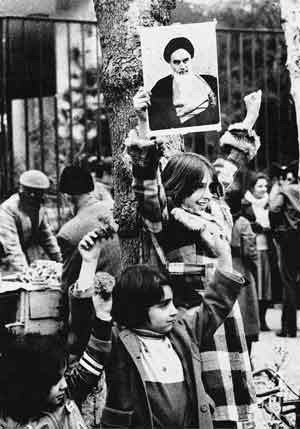 Tehran; the young welcoming Imam Khomeini
Tehran; the young welcoming Imam KhomeiniOn the 1st of February 1979, millions of people came to welcome and witness the Imam's return form Paris. It was a winter morning, but nobody could feel the cold weather. It was dangerous and various threats were made but people still came. It seemed as if the passenger on that airplane had captivated everyone, so that the people forgot all hardships and worries and waited to see the Imam.
Slowly the wheels of the French airplane came to a halt at the Mehr Abad airport runway. A few moments later, the old spiritual man came down the stairs. At that moment, not only Iranians but people all over the world were awaiting the Imam's entrance into Iran. Fourteen years ago, this very man was deported from Iran and people thought he would be forgotten in history. However, it seems that everything was reversed and the assertive powerful men of that era were quickly forgotten and that Imam became the guest of millions of Iranians' hearts. His first words in the airport were, "I thank you all for your love. The Iranian people's affection is a great responsibility on my shoulders, and I cannot repay it. Unity is the key to victory."
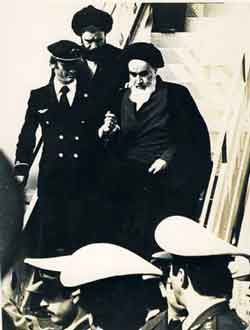 Imam's arrival at Mehrabad airport. Imam,Sayyid Ahmad, pilot(from the right)
Imam's arrival at Mehrabad airport. Imam,Sayyid Ahmad, pilot(from the right)After a while, Imam Khomeini left the airport for the Behest Zahra cemetery in order to visit the graves of the martyrs and pay his respects to them. These martyrs lost their lives for the love of Imam Khomeini. The car carrying Imam Khomeini moved very slowly and finally stopped in front of a particular area in the cemetery, where the martyrs of the revolution were buried. Here Imam Khomeini stated, "We have experienced many tragedies. Some of these tragedies were so great but the victories after them were far greater. There were many tragedies of women losing their husbands, and men losing their children. When I see people whose children died in these movements, I become sorrowful and sense a heavy weight on my shoulders. I am unable to thank a nation who has lost their lives for the sake God."
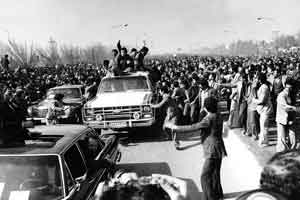 The day of Imam's arrival in Tehran; Imam (in car)being transported and people welkaming him
The day of Imam's arrival in Tehran; Imam (in car)being transported and people welkaming himImam Khomeini then gave a brief description of how the Pahlavi dynasty was established, and then began to explain its illegality and corruptions. He stated: "I will appoint a state. I will act against this government. With the nation's support, I will appoint a state." At the end of his speech, the Imam gave some advice to the army and told the commanders of the army to come back to their people.
Imam Khomeini's first residence was in the "Refah School" near Baharestan Square. After settling there, he started planning the next courses of action. He had to respond to millions of people letters, questions and hundreds who visited him daily at his residence. Imam Khomeini had so much to do that although he was very tired, on the same day he entered Iran he gave a speech at Behesht Zahra cemetery and also issued a statement to the commanders, officers and soldier to stop cooperating with the corrupt government.
Meanwhile, Bakhtiar, the Shah's last prime minister, tried to extinguish the fire of the upcoming revolution and to keep his power. His efforts, however, were futile because of the support of the masses for Imam Khomeini's rise.
Assigning the first Prime Minister of the revolution
A very important and sensitive event took place on the 4th of February. On this day, Imam Khomeini assigned Mehdi Bazargan as the Prime Minister of Iran. This made Iran one step closer to the revolution. Imam asked the people to come to the streets to show their support for this appointment. The next day military jets flew in the skies of Tehran to frighten the people but had no effect whatsoever. On the 8th of February many of the air force personnel marched before Imam Khomeini.
The fall of the Pahlavi regime
During the final hours of Friday the 9th of February, the conflicts between the air force personnel, who were divided into supporters and opponents of the Imam, was dragged outside the barracks. People went to join the military forces that supported the Imam. These conflicts carried on through the next day. The people created obstacles to stop the military forces that had come out with their tanks, ready for another massacre.
At 2pm it was announced on the radio that the military commander of Tehran has declared that a curfew will be imposed after 4:30 pm. The Imam called this curfew a trick and illegal, and asked the people to ignore it.
The sensitivity and danger of this decision by the Imam was such that Ayatollah Talegaani and Bazargaan tried to change the Imam's opinion. They believed that this decision would lead to a massacre. However Imam Khomeini insisted that the people should ignore the curfew. Thus, nobody went home and people stayed in the streets.
Finally on the 11th of February 1979 the army surrendered and announced it would no longer take part in the conflicts. The Imam told people to keep calm and peaceful if the army was to return to the barracks.
The revolution was finally victorious in the evening of the 11th of February 1979. The people's persistence, blood and hard work finally paid off.
Imam's residence, center of decisions
Imam Khomeini's residence was turned into the center of decision-making and everyone waited to hear the decisions that came out from there. From the 11th of February onwards people arrested those who cooperated with the Pahlavi regime and brought them to Imam Khomeini's residence. These arrests were so great in number that the security forces, who stood at the front door, cried out that only the leaders within the Regime could be admitted. It seemed as if the nation wanted to admit every single person who had anything to do with the regime. Furthermore at the Imam's residence the future leaders were chosen.
Imam Khomeini's successive messages asked people to observe peace so they could live their normal lives again and the new state could be established. The Imam stated: "We are now obligated to cooperate with each other and make a new Iran." The first temporary cabinet members of the state began their work on the 22nd of February. Imam Khomeini ordered that all the schools, offices, factories, markets and anywhere else, which was on strike, to begin work again. In the meanwhile, people from different social classes came to visit Imam Khomeini, negotiate with him, and listen to his words. In one of these meetings, a poet who was influenced by the events that had happened to the Imam recited a poem about the Imam. The Imam told him: "It is better for you to write poetry for the poor and those who have sacrificed something".
Visiting the holy city of Qom
Imam's trip to holy city of Qom following his return to the country
 Qom; People's excitement while visiting the Imam
Qom; People's excitement while visiting the ImamOn Thursday morning the 1st of March, Imam Khomeini went to Qom to carry out what he had already promised. This was to not interfere in executive matters, which had to do with the government. The people of Qom and the surrounding towns embraced Imam Khomeini and honoured his arrival. On the first day of Imam Khomeini's entrance to Qom, he thanked the people, especially the people of Qom, and stated, "I am indebted to you… I am your servant".
During the following days, some people and political parties wanted a share of the victory of the revolution. In some parts of the country, movements against Imam Khomeini started. Meanwhile, the provisional government was not powerful enough yet and had difficulties trying to replace the executive practices of the previous state. In these circumstances, where the official governmental system had not been selected yet, Imam Khomeini's responsibility grew heavier and heavier and people expected a miracle. This 76 year-old man was expected to sort out all the problems of the country and to bring about peace. Therefore, in addition to the group meetings, negotiations and response to letters, the Imam held four or five meetings a day and gave an official speech every day.
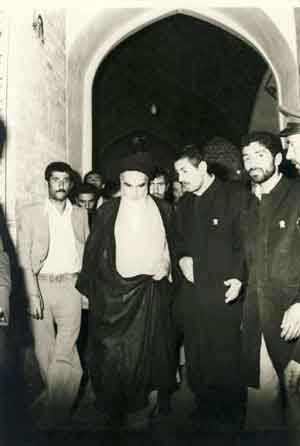 Imam in the vicinity of Hadhrat Ma'soomah's holy shrine; Qom
Imam in the vicinity of Hadhrat Ma'soomah's holy shrine; QomIn one of his speeches Imam Khomeini spoke of those who took no part in the campaigns for the revolution but now, after the revolution, want a share of the victory, and said: "We should obey the nation. We should not hold a pencil, sit at home, and write whatever we want… This… is a betrayal to the nation. This marketer, farmer, and worker…lost loved ones, gave blood, they have a share. All the shares of this revolution belong to them, not you and me who have sat aside and now hold a pencil in our hand."
On the 10th of March, the Imam sent a letter to the Prime Minister, telling him to warn all ministries and governmental departments of the following: "Do not pay attention to my relatives, who refer to particular departments in order to appoint or dismiss figurers for certain positions. My relatives do not have the right to interfere in such matters."
Establishment of an Islamic Republic
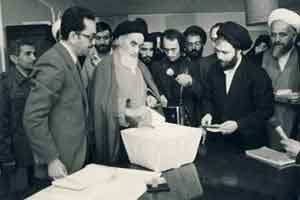 Tehran- Darband; Imam voting for parlimentary candidates
Tehran- Darband; Imam voting for parlimentary candidatesThe Imam tried hard to make people aware of the importance of a referendum, which appointed the type of government people wanted and announced their opinion with regards to an Islamic republic. He frequently repeated the following in his speeches: "You are free to vote for anything you want. I myself will vote for an Islamic Republic."
Finally on Friday the 30th of March 1979 the people voted. The leader of the revolution voted during the early hours of the day. The polls showed that 98% of the people voted for an Islamic republic.
On the 1st of April the Imam congratulated the people for their choice and officially announced the establishment of an Islamic republic. Four days later the Imam formed a constitutional assembly in order for the constitutional laws to be discussed and approved.
Other measures the Imam took were: to order a committee to be formed to help those in need and to open up a bank account with the number 100 as the account number. This account was for those who needed homes and shelters.
 Tehran- Jamaran; the Imam voting
Tehran- Jamaran; the Imam votingOn the 25th of May Imam Khomeini assigned Bazargan, the provisional Prime Minister, the job of perfecting the constitutional laws. The revolutionary council had to approve it and the different sects of people, who were represented by different ministers, had to approve the laws and give their views regarding it.
On the 3rd of August millions of Iranian all over the country came to vote for the ministers of parliament. Seventy five ministers were chosen by the people. These ministers had the responsibility of discussing and approving the constitutional laws.
The simultaneous efforts of the Pahlavi regime's fallen elements, the
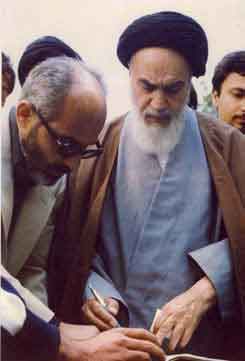 Tehran- Jamaran; the Imam voting
Tehran- Jamaran; the Imam votinginformation services and the security councils of America, Israel and the Soviet Union and some political parties opposing the revolution, were known as the main obstacles in getting the country back to normality. What made Imam Khomeini's work more
difficult were the cries for independence from the cities on the border, tribal disputes, and the assassination of great characters who played great roles in the revolution such as: Vali Allah Qarani, Ayatollah Motahari, Ayatollah Mofateh, Mehdi Araqi, and Hashemi Rafsanjani. Imam Khomeini always tried to keep a good relationship with the people by telling them of all the daily occurrences. This is because he believed that the people are what hold the country and the revolution together. The following events showed that Imam Khomeini's strategies were vital in helping the revolution successfully pass the first few shaky years.
On the 6th of September 1979, the provisional Prime Minister announced that in order to observe the country's affairs and create harmony in the government, the Imam should travel to Tehran. However Imam Khomeini stated that if he came to Tehran it would prevent him from his daily work and thinking about future strategies. Therefore, the provisional Prime Minister found the circumstances too difficult and so after the conquering of the American embassy in Tehran, he resigned. Imam Khomeini transferred his responsibilities to the revolutionary council. Due to various pressures and difficulties the Imam had a heart attack on the 22nd of January 1980 and was transferred to a hospital in Tehran.
Residence in Tehran
Imam Khomeini's trip to Tehran was the reason why he stayed in Tehran for the rest of his life. He was forced to go to Tehran in order to treat his heart attack, and to be near the health centers and the governmental centers of the country. The first year of the revolution showed that despite the establishment of many new organizations in the country, people still turned to Imam Khomeini to solve their problems and give his views regarding different matters.
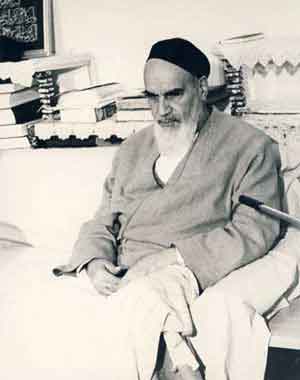 Tehran- Jamaran; Private meetings with the Imam
Tehran- Jamaran; Private meetings with the ImamAfter being treated for 39 days in hospital the Imam was released and stayed at a residence in the Darband area of Tehran. On the 17th of May 1980, the Imam settled down in a small house in Jamaran. This house belonged to one of the religious leaders. The Imam wanted to live in a small house and so he stayed there for the rest of his life.
Imam did all he could to strengthen the roots of the revolution. For instance, on the 4thof February 1980 the Imam authorized the first Prime Minister of the Islamic Republic of Iran even though he was on a hospital bed. Furthermore he issued several statements addressing the people of Iran, the leaders of different countries and others, while he was still in hospital.
Eight-year long imposed war
On the 22nd of September 1980 Iraq launched a war against Iran. This war lasted eight years. The Imam's initial reaction was with great calmness and he asked the people to not get worried. He then issued a statement containing seven articles, which informed the military forces, Iranian intelligence and the people of their responsibilities.
Due to the absence of a ready army, the Imam began to recruit people and train them so that they were ready for war. This was such that after a year, the Iranian army became strong and started to successfully attack back. The army regained its strength.
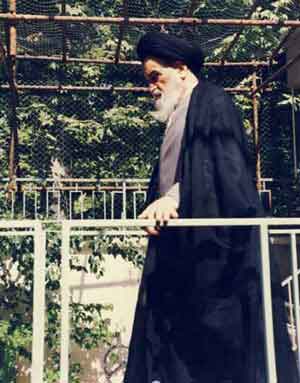 Imam on his way to meet the families of martyrs at Husseiniah Jamaran
Imam on his way to meet the families of martyrs at Husseiniah Jamaran1981 was one of the most difficult years for the Imam, who with his trust in God and intelligence managed to save the revolution from drowning. During this year, in addition to war, our country was subjected to the assassination of great authorities, internal disagreements of the President with other governmental authorities and the parliamentary verdict which ruled that the President was not fit to run office .
After the election of a new president, a bomb explosion killed both the Prime Minister and the new President. The internal and external threats endangered the survival of the revolution. During this time Imam Khomeini issued promising words to the people which disappointed the enemies. He said: "A country which has moved to be free and independent from other Western and Eastern powers should prepare itself for upcoming occurrences. This is a tradition which has reached us from the beginning of Islam, when the religious people stood firm against all insecurities, hardships and upsets."
Although the year 1981 passed with great difficulties, the year 1982 brought many great victories with it. Imam Khomeini's words boosted the morale of the men, who were ready to sacrifice their lives for him. These men stood against the modern weapons of the enemy and defeated them. These men freed KhoramShahr and other occupied cities from enemy hands. If the super powers had not helped Iraq, Iran would have freed these lands much sooner.
1987 and 1988 were the most devastating years for Iran. In these years, most of Iran's cities especially Tehran were attacked by Iraqi bombs and there were many casualties. The chemical attacks had disastrous consequences both for the military forces and civilians. The help and aid the U.S gave Iraq made the war more complex and destructive. Due to the fact that Imam Khomeini saw the roots of the Islamic Republic getting weaker and weaker, he announced his agreement to end the war.
On the 20th of July 1988, the Imam issued a statement in which he agreed to the conditions of manifesto 598 of the United Nations and stated: "Until to a few days ago, I believed in defense and saw it beneficial for the country and revolution but due to some events and reasons which I will not mention for now… I agreed to end the war and accept the conditions of the manifesto." In the continuation of this statement the Imam said: "For me, announcing my agreement to this issue is worse than taking poison. However, I am satisfied with God's satisfaction and I agreed to this for His satisfaction".
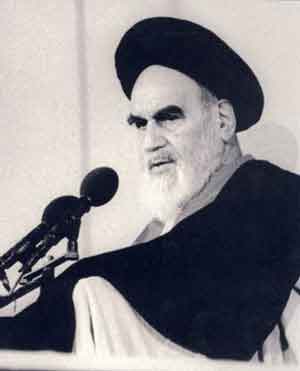 Tehran- Husseiniah Jamaran; Imam giving a speach
Tehran- Husseiniah Jamaran; Imam giving a speachIraq misinterpreted Imam Khomeini's words as a sign of weakness and attacked Iran with more forces but the people of Iran defeated them and made the possibility of another war on Iran remote. Thus, the most important part of Imam Khomeini's leadership, which lasted 8 years finished. Imam Khomeini did not allow any Iranian land to fall in the hands of the enemy and was successful in getting the country through this challenging eight year phase.
One of the other important instances during Imam Khomeini's life was his letter to Mikhail Gorbachev, who was head of state of the Soviet Union. In his letter, the Imam invited Gorbachev to Islam and monotheism and stated that the Islamic Republic of Iran can easily fill the existing religious vacuum in their system.
On the 13th of February 1989 Imam Khomeini sentenced the author of "Satanic verses" to death. Since then no one has dared to insult Islam in such a way.
Death (1989)
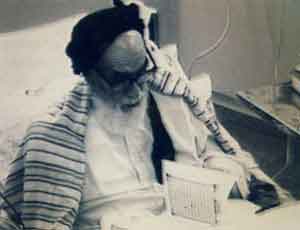 Jamaran Heart Hospital; Imam reading the Qur'an while on a hospital bed
Jamaran Heart Hospital; Imam reading the Qur'an while on a hospital bedTuesday the 22nd of May 1989 was a sorrowful day for all those who were supporters and followers of the Imam. On this day the 2pm news reported that the Imam's bleeding digestive system needed an emergency surgery. People were so concerned that they went to the mosques and prayed for Imam Khomeini to get well. The updates that Imam Khomeini's doctors gave indicated promising news. However on the 2nd of June worrying news spread throughout the country. People started to pray again for Imam Khomeini and kept reading the following holy verse: "He Who answers the desperate one when he calls to Him and Who removes [his] distress".
The 3rd of June was a tragic day, the 7 am news on the radio stated the following: "In the name of God, to God we belong and to Him we return. The holy spirit of the leader of Muslims and free men, Imam Khomeini, has gone to meet his creator."
Upon hearing the news, people went into the streets and cries could be heard from every corner. Tehran and all the cities of Iran mourned this great loss. Hosseiniyaya Jamaran, where the Imam sometimes gave his speeches, was covered with black cloth and people came to mourn the loss of their leader.
 Tehran; The restless crowd mourning the Imam's death
Tehran; The restless crowd mourning the Imam's deathOn the morning of the 5th of June millions of people came to bid farewell to a leader who they loved. Millions of people all around the world saw incredible scenes, which showed how the people said goodbye to their leader. It has been recorded that over 10 million people attended his funeral. This day reminded the Iranian nation of the 31st of January. Imam Khomeini captured the hearts of millions of people. Imam Khomeini's body was buried next to the graves of thousands of martyrs who had lost their lives for their country. The blessings his life bestowed upon people did not finish with his passing and still continues to illuminate people's lives today.

